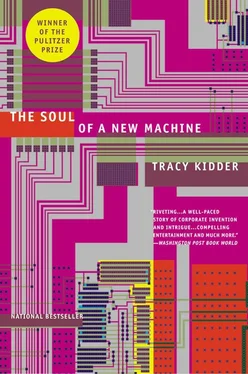Scientists and engineers, it seems, were the first to express a desire for a relatively inexpensive computer that they could operate themselves. The result was a machine called a minicomputer. In time, the demand for such a machine turned out to be enormous. Probably IBM could not have controlled this new market, the way it did the one for large computers. As it happened, IBM ignored it, and so the field was left open for aspiring entrepreneurs—often, in this case, young computer engineers who left corporate armies with dreams of building corporate armies of their own.
For many years sociologists and others have written of a computer revolution, impending or in progress. Some enthusiasts have declared that the small inexpensive computer inaugurated a new phase of this upheaval, which would make computers instruments of egalitarianism. By the late seventies, practically every organization in America had come to rely upon computers, and ordinary citizens were buying them for their homes. Within some organizations small bands of professionals had exercised absolute authority over computing, and the proliferation of small computers did weaken their positions. But in the main, computers altered techniques and not intentions and in many cases served to increase the power of executives on top and to prop up venerable institutions. A more likely place to look for radical change was inside the industry actually producing computers. Generally, that industry grew very big and lively, largely because of a single invention.
Shortly after World War II, decades of investigation into the internal workings of the solids yielded a new piece of electronic hardware called a transistor (for its actual invention, three scientists at Bell Laboratories won the Nobel Prize). Transistors, a family of devices, alter and control the flow of electricity in circuits; one standard rough analogy compares their action to that of faucets controlling the flow of water in pipes. Other devices then in existence could do the same work, but transistors are superior. They are solid. They have no cogs and wheels, no separate pieces to be soldered together; it is as if they are stones performing useful work. They are durable, take almost no time to start working, and don’t consume much power. Moreover, as physicists and engineers discovered, they could be made very small, indeed microscopic, and they could be produced cheaply in large quantities.
The second crucial stage in the development of the new electronics came when techniques were developed to hook many transistors together into complicated circuits—into little packets called integrated circuits, or chips (imagine the wiring diagram of an office building, inscribed on the nail of your little toe). The semiconductor industry, which is named for the class of solids out of which transistors are made, grew up around these devices and began producing chips in huge quantities. Chips made spaceships and pocket calculators possible. They became the basic building blocks of TVs, radios, stereos, watches, and they made computers ubiquitous and varied. They did not eliminate the sizable, expensive computer; they made it possible for the likes of IBM to produce machines of increased speed and capability and still make handsome profits without raising prices much. At the same time, the development of chips fostered an immense and rapid growth of other kinds of computing machines.
After mainframes, as the big computers were known, came the cheaper and less powerful minicomputers. Then the semiconductor firms contributed the microprocessor, the central works of a computer executed on a chip. For a while, the three classifications really did describe a company’s products and define its markets, but then mainframers and microcomputer companies started making minis and minicomputer companies added micros and things that looked like mainframes to their product lines. Meanwhile, a host of frankly imitative enterprises started making computers and gear for computers that could be plugged right into systems built around the wares of the big successful companies. These outfits went by the names of “plug compatibles” and “third-party peripheral manufacturers”; those who lost some business to them called them “knockoff companies.” Probably they helped maintain competition in prices. Many “software” houses sprang up, to write programs that would make all those computers actually do work. Many customers, such as the Department of Defense, wanted to buy complete systems, all put together and ready to run with the turn of a key; hence the rise of companies known as original equipment manufacturers, or OEMs—they’d buy gear from various companies and put it together in packages. Some firms made computer systems for hospitals; some specialized in graphics—computers that draw pictures—and others worked on making robots. It became apparent that communications and computing served each other so intimately that they might actually become the same thing; IBM bought a share in a satellite, and that other nation-state, AT&T, the phone company, started making machines that looked suspiciously like computers. Conglomerates, of which Exxon was only the largest, seemed determined to buy up every small computer firm they could. As for those who observed the activity, they constituted an industry in themselves. Trade publications flourished; they bore names such as Datamation, Electronic News, Byte, Computermania . IBM, one executive of a mainframe company once said, represented not competition but “the environment,” and on Wall Street and elsewhere some people made a business solely out of attempting to predict what the environment would do next.
I once asked a press agent for a computer company what was the reason for all this enthusiasm. He held a hand before my face and rubbed his thumb across his fingers. “Money,” he whispered solemnly. “There’s so goddamn much money to be made.” Examples of spectacular success abounded. The industry saw some classic dirty deals and some notable failures, too. RCA and Xerox lost about a billion dollars apiece and GE about half a billion making computers. It was a gold rush. IBM set up two main divisions, each one representing the other’s main competition. Other companies did not have to invent competitors and did somewhat more of their contending externally. Some did sometimes use illicit tools. Currying favor, seeking big orders for chips, some salesmen of semiconductors, for instance, were known for whispering to one computer maker news about another computer maker’s latest unannounced product. Firms fought over patents, marketing practices and employees, and once in a while someone would get caught stealing blueprints or other documents, and for these and other reasons computer companies often went to court. IBM virtually resided there. Everyone sued IBM, it seemed. The biggest suit, the Jarndyce v. Jarndyce of the industry, involved the Justice Department’s attempt to break up IBM. Virtually an entire large law firm was created to defend IBM in this case, which by 1980 had run ten years and had been in continuous trial for several.
Data General took its place in this bellicose land of opportunity in 1968, as a “minicomputer company.” By the end of 1978 this increasingly undescriptive term could in some senses be applied to about fifty companies. Their principal but by no means their only business, the manufacture and sale of small computers, had grown spectacularly—from about $150 million worth of shipments in 1968, to about $3.5 billion worth by 1978—and it would continue to grow, most interested parties believed, at the rate of about 30 percent a year. By 1978 Data General ranked third in sales of minicomputers and stood among the powers in this segment of the industry. The leader was Digital Equipment Corporation, or DEC, as it is usually called. DEC produced some of the first minicomputers, back in the early sixties. Data General was the son, emphatically the son, of DEC.
Читать дальше











